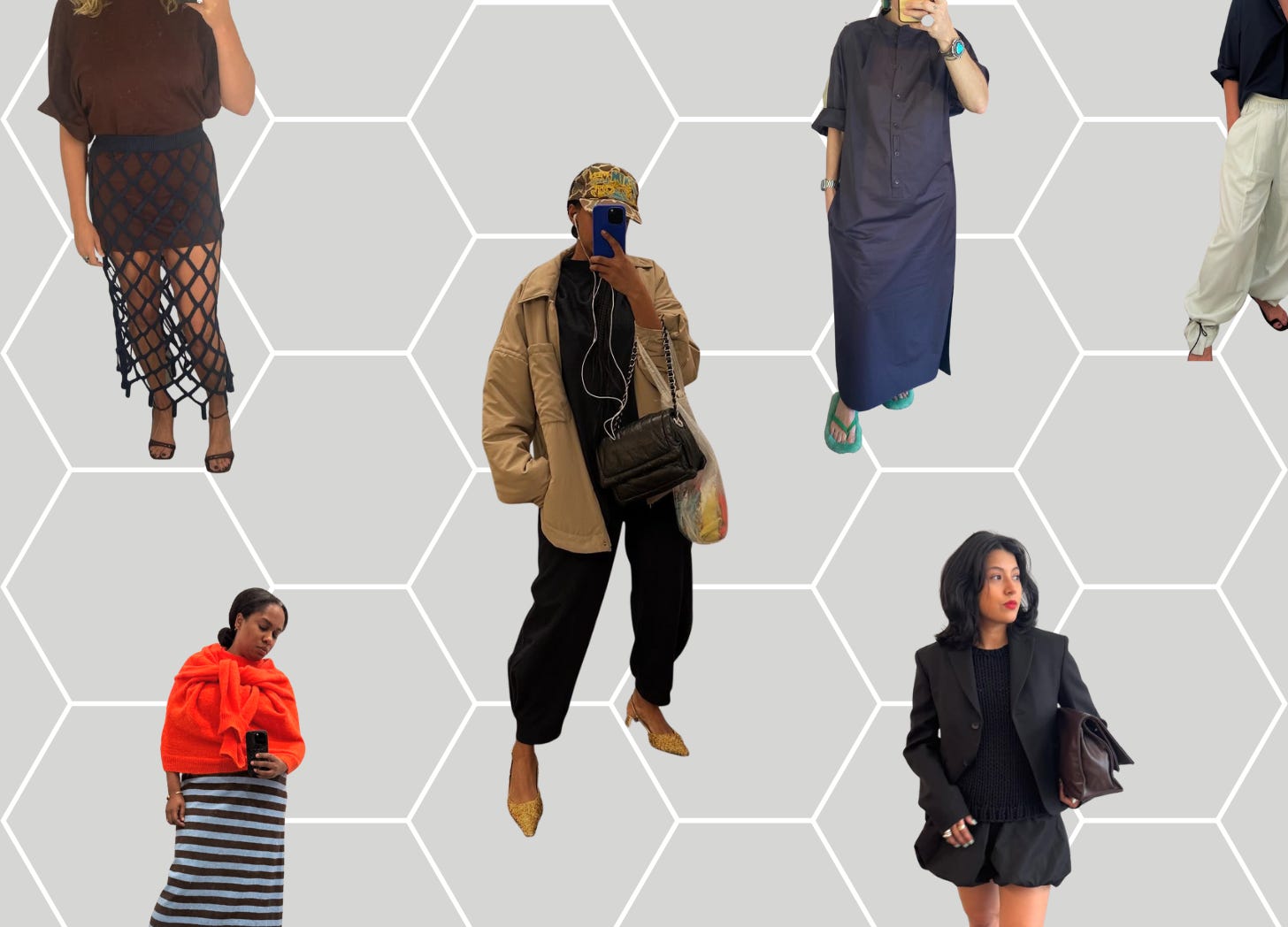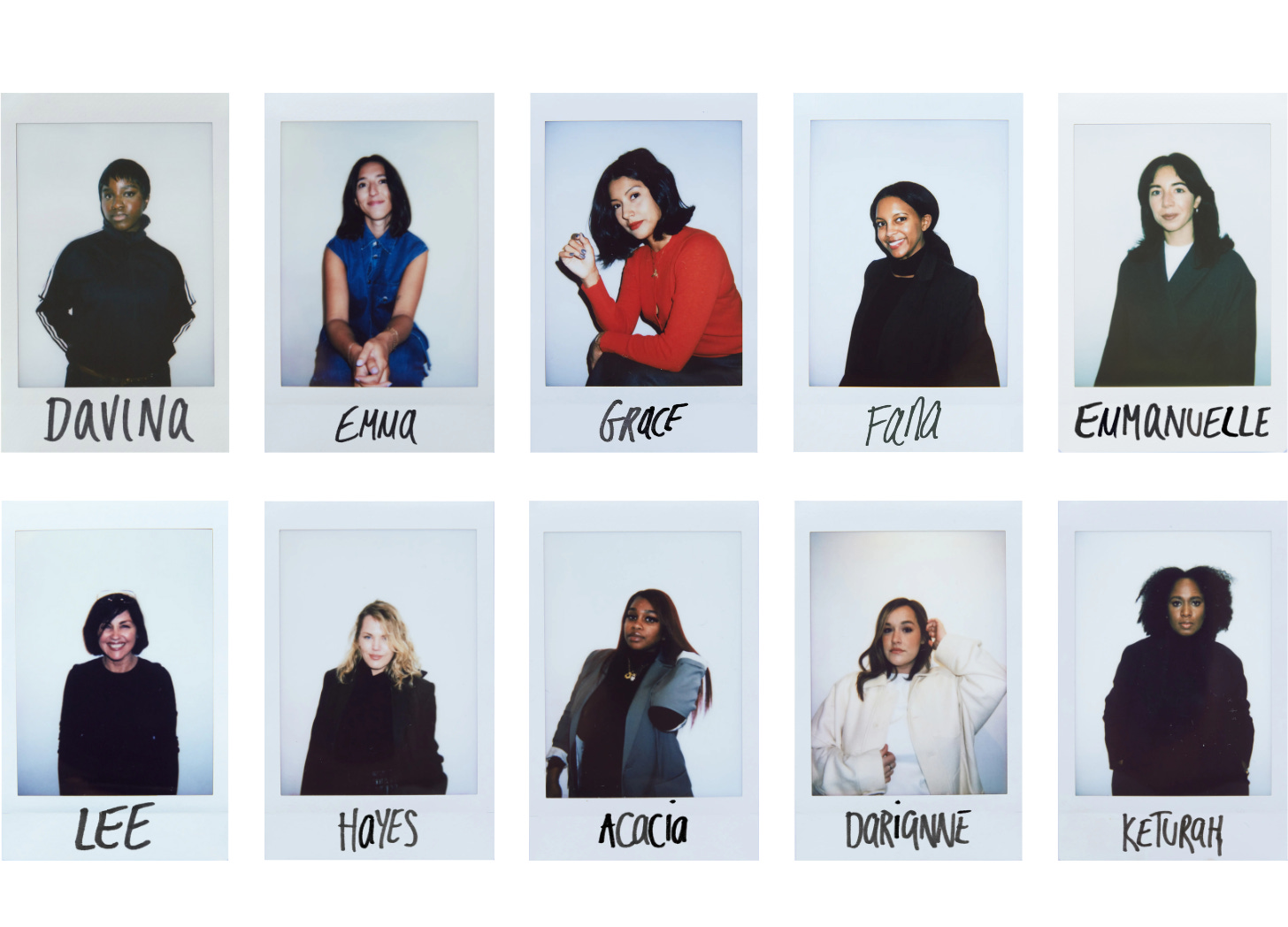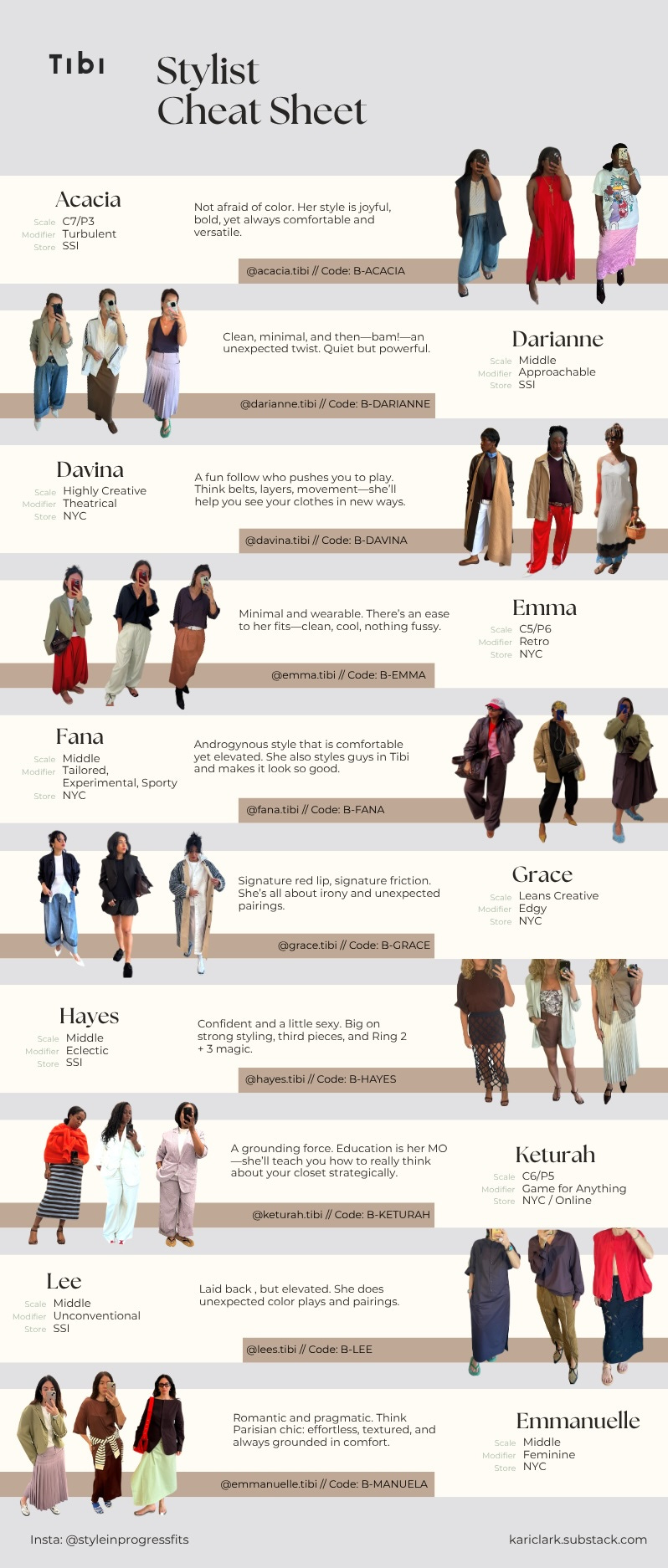Inside Tibi Styling: My Conversation with Keturah + Exclusive Stylist Cheat Sheet
One stylist, dozens of insights—and the only place you’ll find every Tibi stylist’s personal modifier and CP scale.
If you’re deep in the Tibi world, you know the language: modifiers, CP scale, Ring 3. But even when you speak fluent Tibi, it’s not always clear what to actually buy.
The drops come fast. By the time you’ve made one decision, something new is already live. I just put in my 70% off sale order–and now the Fall Collection has launched. (Yes, I’m still swooning over those cream Bronsons.)
That’s where the stylists come in.
I first met Keturah at The Shoe Hive, lugging in a few problem pieces. I had a closet full of bottoms and no real strategy. She helped me figure out what category to invest in next: sweaters. And, she was right. Tibi’s sweaters are good.
So when I wanted to understand how the Tibi styling program actually works—and what makes it so effective—she was the obvious person to call. We talked about what really happens in a session, the life shifts that bring people in, and what makes someone a dream client (spoiler: it’s not a spreadsheet, but that doesn’t hurt).
And because I’m modifier-obsessed, I also pulled together something I haven’t seen anywhere else: a Stylist Cheat Sheet—complete with every Tibi stylist’s personal modifier and CP scale.
If you’ve ever wondered who’s modifier is “Game for Anything,” the Cheat Sheet delivers.

What Stylists Actually Do
Tibi stylists are there to teach you how to wear the clothes—not just sell them. Keturah explained how they came to have such an impact at the brand:
"When I was brought on, the store was outperforming the website, which is really odd in this era. But the difference was the stylists. Our DNA is education. And the only way you can educate people is if you have people actually doing that work.
So after Amy opened her life up on Instagram in 2020, we started having the stylists do that, too. That way our stylists could work virtually with people everywhere.”
Here’s what working with a stylist can actually look like:
Prioritizing a wishlist (especially around sales or the new drops)
Strategically filling wardrobe gaps
Back-channeling for hard-to-find items
Helping you understand why a piece works, or doesn’t
Sending different views of an item so you’re not relying on website photos alone
Breaking down CP principles in a way that applies to your closet
Packing help for trips or big life shifts (yes, please)
As Keturah told me:
“It’s not just about styling. It’s about having someone be your educational tool.”
Two of the most surprising ways stylists help?
“When we shop, we often shop in the moment because of emotions. A stylist can give you guidance to say, ‘you don’t need that.’”
And this one really surprised me:
“Sometimes I go outside the Tibi realm to show them things to supplement their Tibi purchases. If someone can’t wear heels and nothing in our line-up works, I’ve found shoes on other sites. I just want to help people understand how to wear their Tibi clothing.”
When to Book a Styling Session
Stylists aren’t just for wedding weekends or capsule wardrobes in Mykonos. Some of the most helpful sessions happen during quieter, in-between moments—like when:
You’re new to the brand and want help decoding it
You bought something but can’t seem to style it
Your sizing feels inconsistent or confusing
You’ve gone through a change—new job, new body, new routine
Keturah put it this way:
“Everybody’s going through something. Maybe you gained weight. Maybe you’re retiring. Maybe you're a boss. Maybe you just want to get the brand. Styling helps you see how to dress for the life you actually have.”
In my case, I had tried on or ordered four different Liams before working with Keturah. (Send help.) She gently pointed me toward the Drapey Suiting version, saying it would probably fit my lifestyle best. She was right—I now own the Cinnamon one, and I love it.
How Stylists Get to Know You
This was the part I was most nervous about—like, is she going to judge my fit? Was I about to star in a one-woman What Not to Wear reboot?
Keturah totally got that hesitation:
“People are afraid it will be like one of those styling shows that we were all burned by. They worry, ‘What are they going to tell me? They’re not going to like my clothes.’
But that’s not the vibe at all. We’re holding your hand, doing something that most people pay for.”
She starts by asking questions that feel more therapy than fashion:
“I met with someone yesterday who said it’s her birthday. So I mentally note that she’s in a moment of reflection. She’s feeling fresh. And then I asked her what her lifestyle is like. Do you work from home? Do you have kids? Do you party on the weekend?
I also ask people when they’re unsure of where they are in life: Who were you in college? Who were you at your happiest?”
It turns out, figuring out what to wear starts with figuring out where you’re at.

How to Be an A+ Student
There’s no right way to show up. Some people bring spreadsheets. Some bring a vibe.
Keturah said:
“My A+ clients? They’re open. They communicate. I like when people say, ‘I need this’ or ‘I definitely don’t need that.’ I’m always going to try and push you a little farther than you’re wanting because my role is to educate you and open you up to new things.
Some type of documentation of what you have is also helpful. That could be selfies on your phone or walking through your closet. There is no shame, but at one glance, we can see that you’re not somebody that wears red. I can see where the opportunities are.“
You don’t need a system. But bringing a few photos and a little honesty makes a big difference.
How to Pick the Right Stylist
Keturah said:
“A lot of people come to me because I’m curvy or I’m tall. ‘I see myself in you.’ It goes beyond race and culture. It’s more about ‘I like this person’s style. They’re an aspiration for me.’”
When I was trying to figure out my own modifier earlier this year (a saga for another post), I kept gravitating toward certain stylists—but couldn’t always explain why. That’s what made me curious to dig deeper and gather their official modifiers and CP scale placements.
Their modifiers are surprisingly precise—and incredibly helpful for choosing who to work with.
The Stylist Cheat Sheet
So I pulled everything together in one place: Each stylist’s modifier. Their CP scale placement. Their location and Instagram. A quick vibe check, too.
If you’re trying to figure out who to book (or just modifier-curious like I was), this will help.
Keturah’s Advice for Getting Started
I asked her what she tells people who are new to the brand or just dipping a toe in.
“My biggest advice is to just be open to buying one piece to see how it flips the script on what you already own. I usually start with shoes—it completely changes everything, whether it’s vintage or high-end or low-end.”
“My second advice is to break it down into categories. Think: jacket, pant, jean, shirt, shoe. If you have one elevated piece in each of those, it will elevate everything you own.”
What’s Next
You can book a session directly at tibi.com/pages/stylists. They’re free, and you can do them virtually or in-person at either the NYC Flagship or the St. Simons store. If you end up ordering something after, don’t forget to use your stylist’s code at checkout (you’ll find it in the B codes on the cheatsheet)—they’ll get commission for the support they gave you.
It’s not about pressure.
It’s about perspective.
And maybe—just maybe—a new Liam in your future.
P.S. Keturah’s now on Substack, sharing her signature “Low Key Important” stacks. Highly recommend a follow. I’m excited to get even more inside her brain.


I really loved this. This is so wholesome - davina
🙋🏼♀️ Um, I don’t even speak toddler Tibi. “Modifiers, CP scale, Ring 3” What do these terms mean??? I’m becoming more interested in the brand and want to try to understand it better. Thank you! 😊